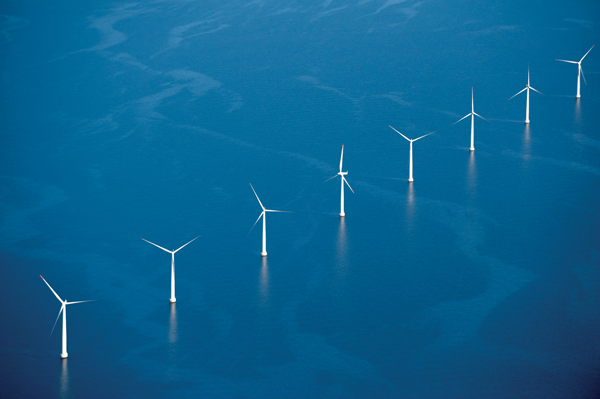DETI’s Offshore Renewable Energy Strategic Action Plan
Offshore wind and tidal technology could be operating off Northern Ireland’s coast from 2016. However, progress is faster across the rest of the United Kingdom and in the Republic.
DETI’s Offshore Renewable Energy Strategic Action Plan outlines the Executive’s aim of Northern Ireland generating 900MW of energy from offshore wind and 300MW from tidal resources by 2020. At present, a 1.2MW SeaGen tidal stream demonstration project is operated by Queen’s University in Strangford Lough. The lough has not been considered suitable for commercial scale development, due to the potential damage to the environment and other marine users. However, that project and Queen’s marine laboratory at Portaferry will continue to host early stage testing of prototype devices.
There are currently 22 offshore wind sites off the coast of England with a total installed capacity of 6.1GW. Two wave technology projects have an installed capacity of 20.5MW and two tidal projects have a combined installed capacity of 12MW.
Scotland currently has five offshore wind sites with a combined installed capacity of 1.18GW. Four wave technology sites have a combined installed capacity of 7.76MW and three tidal projects have a combined installed capacity of 4.64MW. In addition, the Pentland Firth and Orkney waters are the first area in the UK to be made available for commercial scale development of wave and tidal energy. The Crown Estate has entered into agreements for lease for projects with a potential capacity of up to 1.6GW in what is believed to be the largest such development worldwide.
While there is no offshore wind off the Welsh coast, one wave project has an installed capacity of 7MW and two tidal sites have a combined installed capacity of 11.7 MW.
Foreshore leases have been granted for the operation of two sites in Ireland: a 520MW wind farm on the Arklow Bank and a 1.1GW wind farm on the Codling Bank. To date, seven turbines totalling 25.2MW have been installed on the Arklow Bank. Ocean energy research is underway in three universities and at two marine test sites, one in Galway Bay and one in Belmullet, County Mayo.
During 2011, electricity consumption from renewables (mainly onshore wind) in Northern Ireland was an average of
12 per cent (increasing to 18 per cent in some months). Energy Minister Arlene Foster admits that “the development of renewables is undoubtedly a big challenge” but she sees offshore energy as “making a key contribution to our future energy mix.”
The draft Offshore Renewable Energy Strategic Action Plan underwent a strategic environmental assessment (SEA) before both documents were published for a three-month consultation from December 2009 to March 2010. A post-consultation report was published in September 2010, recommending that a habitats regulations appraisal (HRA) of the draft strategic action plan. This took place from October 2010 to March 2011.
One year passed between the publication of the draft strategic action plan and the final document because the HRA had to undergo a consultation and was approved by the Northern Ireland Environment Agency (NIEA) in July 2011. Discussions on the location of the maritime border took place until November 2011 and the Executive approved the final document for publication in March 2012.
In December 2011, the Crown Estate announced two parallel offshore leasing rounds in Northern Ireland waters: an offshore wind area off the east coast of County Down to deliver up to 600MW of capacity and a tidal stream area off the north coast around Rathlin Island to deliver up to 200MW.
The strategic action plan’s timetable states that the Crown Estate will offer development plans to successful companies by September 2012. Environmental impact assessments and habitat regulation appraisal requirements will be carried out between 2012 and 2015, and construction and deployment should take place in 2015 and 2016 (depending on private sector interest).
Confusion over the maritime border between Northern Ireland and the Republic was temporarily resolved when a memorandum of understanding for offshore renewables was signed by Julian King (while he was UK Ambassador to Ireland) and Irish Foreign Affairs Minister Eamon Gilmore in December 2011. This allows the UK and Irish governments to grant leases in their respective waters up to a line drawn half-way between the mouth of Lough Foyle out to the Crown Estate’s 12-nautical mile boundary and half-way between the mouth of Carlingford Lough out to the 12-nautical mile limit. DETI intends to work towards making this a legal commitment.
Key actions
The SEA and HRA made three recommendations which DETI intends to carry out before the end of the year:
• ensure that gaps in knowledge and strategic data are filled by having Northern Ireland included in UK-wide studies (the region is currently represented on UK-wide research groups such as the Offshore Renewable Research Steering Group);
• adopt a ‘deploy and monitor’ approach to marine renewable energy based on Marine Scotland’s approach to its marine licensing regime in the Pentlands Firth; and
• publish a ‘project level mitigation strategy’ which will outline best practice required to gain consent.
By developing a programme to fill knowledge gaps by this autumn, DETI hopes that developers will be encouraged to invest in the region as they will no longer have to undertake and pay for their own surveying or monitoring.
DETI intends to publish a ‘survey, deploy, monitor’ approach for Northern Ireland waters by December 2012 so that regulators and potential investors will have the necessary information about the environmental impact. Also by December 2012, DETI, in conjunction with the NIEA will publish the mitigation strategy as a reference guide for regulators, developers and stakeholders.
DETI established the Offshore Renewable Energy Forum in January 2011 to advise on the delivery of the strategic action plan. It includes representatives from fishing, ports and harbours, the renewable industry, Invest NI, environmental groups and local authorities.
The electricity grid must be strengthened to accommodate onshore and offshore renewables. DETI says it will work with NIE, SONI and the Utility Regulator to handle this development. The findings of the ISLES offshore grid study will be “continually used” to inform decisions on renewable infrastructure.
Invest NI is working with the Sustainable Energy Authority of Ireland and the DECC to establish potential business and supply chain activities that could arise from offshore developments.
The department wants to ensure that its offshore energy interests are represented in the Marine Bill which will legislate for marine planning and conservation of marine nature (see pages 22-23).
Safety zones and the statutory decommissioning of offshore infrastructure have not yet been legislated for in Northern Ireland. DETI intends to develop proposals, based on those operating within Great Britain’s waters, and will mention this in the Energy Bill consultation which is scheduled for spring 2012.
With electricity market reform underway in Britain, DECC is developing new legislation which will include the powers to introduce a feed-in-tariff with contracts for difference for large scale renewables. DETI is currently considering how these proposals could be shaped to work within the Single Electricity Market and the Minister is to announce her decision this spring. A DETI spokeswoman confirmed that her decision and the consultation on an Energy Bill are due before the end of May.






